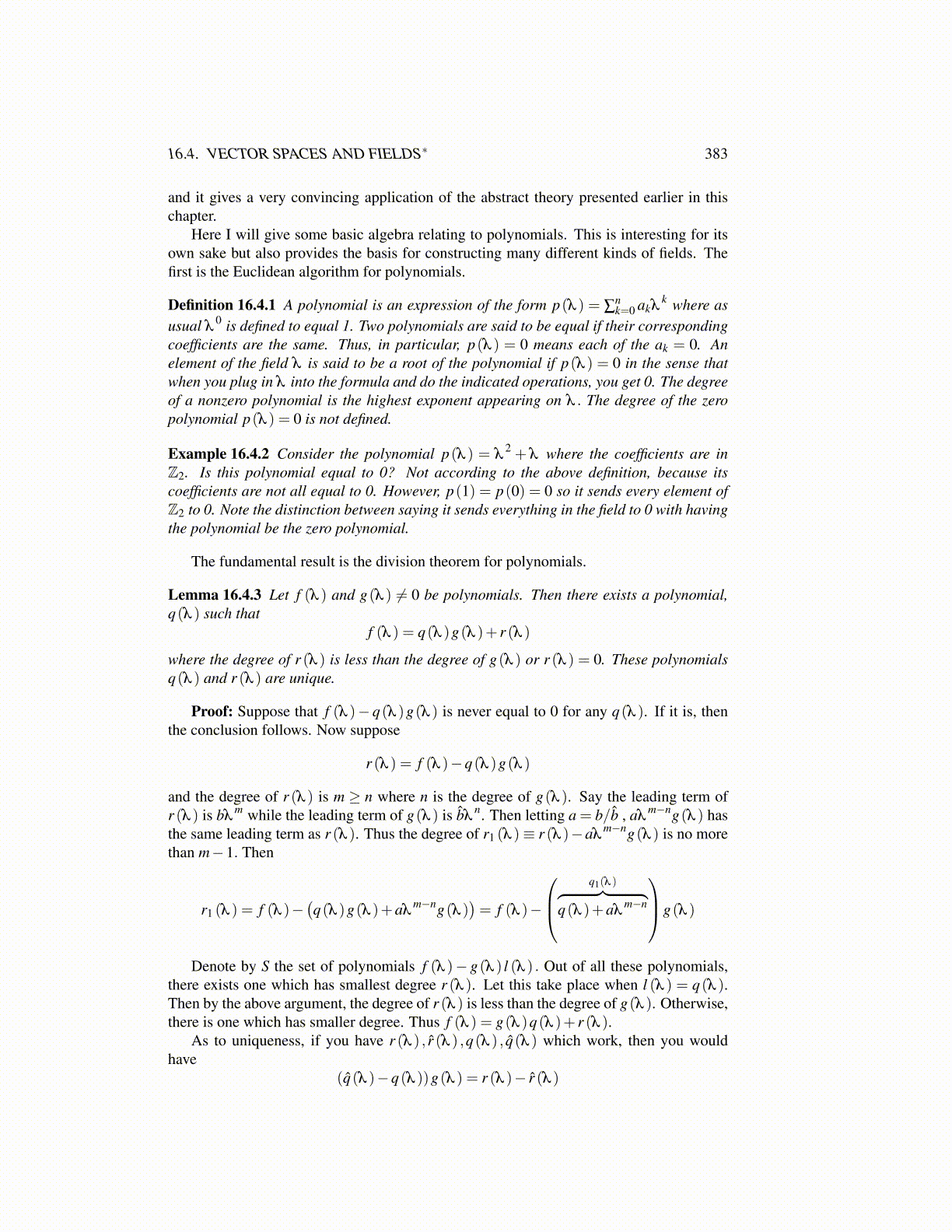
16.4. VECTOR SPACES AND FIELDS∗ 383
and it gives a very convincing application of the abstract theory presented earlier in thischapter.
Here I will give some basic algebra relating to polynomials. This is interesting for itsown sake but also provides the basis for constructing many different kinds of fields. Thefirst is the Euclidean algorithm for polynomials.
Definition 16.4.1 A polynomial is an expression of the form p(λ ) = ∑nk=0 akλ
k where asusual λ
0 is defined to equal 1. Two polynomials are said to be equal if their correspondingcoefficients are the same. Thus, in particular, p(λ ) = 0 means each of the ak = 0. Anelement of the field λ is said to be a root of the polynomial if p(λ ) = 0 in the sense thatwhen you plug in λ into the formula and do the indicated operations, you get 0. The degreeof a nonzero polynomial is the highest exponent appearing on λ . The degree of the zeropolynomial p(λ ) = 0 is not defined.
Example 16.4.2 Consider the polynomial p(λ ) = λ2 + λ where the coefficients are in
Z2. Is this polynomial equal to 0? Not according to the above definition, because itscoefficients are not all equal to 0. However, p(1) = p(0) = 0 so it sends every element ofZ2 to 0. Note the distinction between saying it sends everything in the field to 0 with havingthe polynomial be the zero polynomial.
The fundamental result is the division theorem for polynomials.
Lemma 16.4.3 Let f (λ ) and g(λ ) ̸= 0 be polynomials. Then there exists a polynomial,q(λ ) such that
f (λ ) = q(λ )g(λ )+ r (λ )
where the degree of r (λ ) is less than the degree of g(λ ) or r (λ ) = 0. These polynomialsq(λ ) and r (λ ) are unique.
Proof: Suppose that f (λ )− q(λ )g(λ ) is never equal to 0 for any q(λ ). If it is, thenthe conclusion follows. Now suppose
r (λ ) = f (λ )−q(λ )g(λ )
and the degree of r (λ ) is m ≥ n where n is the degree of g(λ ). Say the leading term ofr (λ ) is bλ
m while the leading term of g(λ ) is b̂λn. Then letting a = b/b̂ , aλ
m−ng(λ ) hasthe same leading term as r (λ ). Thus the degree of r1 (λ )≡ r (λ )−aλ
m−ng(λ ) is no morethan m−1. Then
r1 (λ ) = f (λ )−(q(λ )g(λ )+aλ
m−ng(λ ))= f (λ )−
q1(λ )︷ ︸︸ ︷
q(λ )+aλm−n
g(λ )
Denote by S the set of polynomials f (λ )− g(λ ) l (λ ) . Out of all these polynomials,there exists one which has smallest degree r (λ ). Let this take place when l (λ ) = q(λ ).Then by the above argument, the degree of r (λ ) is less than the degree of g(λ ). Otherwise,there is one which has smaller degree. Thus f (λ ) = g(λ )q(λ )+ r (λ ).
As to uniqueness, if you have r (λ ) , r̂ (λ ) ,q(λ ) , q̂(λ ) which work, then you wouldhave
(q̂(λ )−q(λ ))g(λ ) = r (λ )− r̂ (λ )